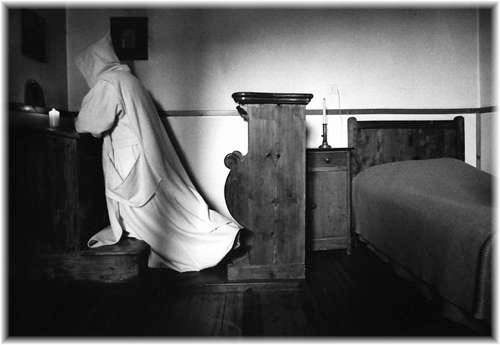Thomas Merton complained at various times that he tired of being asked the endless questions often posed to a hermit, monk or recluse, "Why do you live this way"? "Why a hermit or monk"?
As the eremetic life continues to grow and religious people live a life of prayer in our midst once again, it is critical for our culture that these questions be asked less and less.
The new code of Canon Law 602 & 603 allow for people to profess the evangelical counsels of Poverty, Chastity, and obedience to their local Ordinary (Bishop). Diocesan Hermits are growing in number every year.
They submit a plan of life to the Bishop and can be approved n a form of life that was quite common and essential to the early Church. Sister Wendy Becket of PBS fame, for example is officially a Diocesan Hermit and Consecrated virgin,not an "nun".
In a truly religious society, Merton reminds us, hermits and monks are simply taken for granted. They are quizzed as to God, Creation, and prayer, not their raison d'être.
In may parts of the world, hermits and anchorites are lovingly supported as the praying heart of the Church. They are supported morally and temporally. This is still true in Greece, a reviving Russia and seen in such historic persons as Julian of Norwich and her fellow anchorites in a once religious England.
As a Theology teacher of high school seniors, I recently had the opportunity to teach solitude. As part of the standard Vocations course, I held an integrated mini-seminar on "The Quiet Life". While the students have ample opportunity to interact and appreciate active religious, most have never encountered a hermit or seen a monk before.
After some standard introduction and reading an article by a monastic from a vocation magazine, the students list a few preconceived notions of monks and hermits. We then view a new film by the monks of St. Joseph's Abbey, Spencer, MA. Entitled, With Heart's Expanded, it simply and pleasantly presents the silent life in a relevant and vibrant manner.
Through the half-hour film, the students see, hear and ponder God, monks, prayer, and are quite aware that there are people whose prime purpose in life is to seek the Almighty. We then review the new Canons 603 & 604 and read Merton's introduction to his book The Silent Life. We close with an open discussion and short reflection paper. They truly enjoy the novelty of the subject, delight in the Trappist film and find Merton quite readable and enjoyable.
Several students have since chosen to read Merton for a related course project. I also introduce them to the life of the Carthusian and the possibilities of being a lay contemplative in the world. The response is incredible. They are openly delighted and intrigued by what they read, see, and experience.
Many confess a gratitude for the seminar and gladly express that their formally secular attitude about religious in general, and especially monks and hermits, have changed.
Their written work displays a high level of engagement and interest. In fact, of all the work I have ever read, this seminar produced the one of the largest percentage of sincere, heartfelt response. They truly addressed the subject in a relevant and interactive manner.
Many confessed a gratitude that such people exist. "Since these people live in this manner", many reasoned, "then God must exist and live among us". For many of these eighteen year olds this is their first encounter with solitude and a life of prayer. They find a natural attraction to prayer and people of prayer.
My students come from a variety of background, urban, suburban and rural. They are both representative of the working class and the well off. Many drive much nicer cars than I or the other faculty.
While many, if not all, doubt they could ever live such a life, many feel called to share in some small manner of this special and integral calling. A good number admitted feeling called to pray more and seek a bit more silence.
Some related personal stories of prayer, priests, nuns and relations who had changed there life and were great sources of wisdom and counsel for them. They wished for more such people to flourish in the Church.
As Christ has a body at work on this earth, that body, many of my students now agree, has an essential praying soul. The hermits and monks of this world fill this critical link in all our lives. A truly united Church, that is one in mind and soul, should hopefully contain a large body that naturally understands and embraces its brothers and sisters who labor in that small, still place before the face of the living God.
Teaching solitude is much easier than I thought. My very modern, secularized students actually stopped for a moment and considered a life of prayer and those, who they now believe, labor fruitfully in that field.
Their openness and desire to know more and their continued commentary upon the silent life is an encouragement to myself and this growing soul of the Church.
